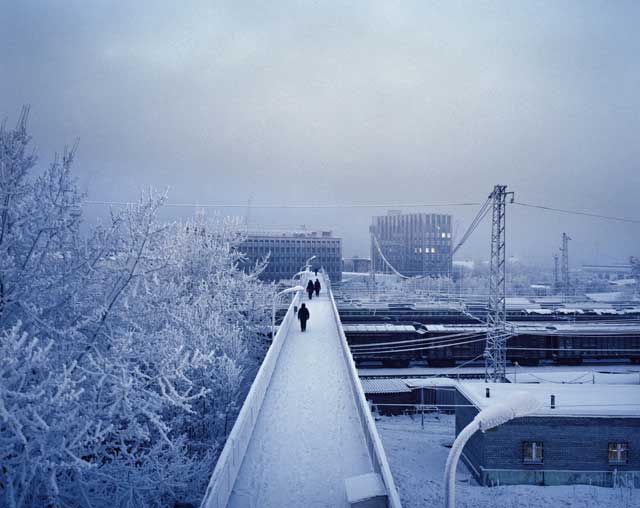Simon Roberts: Welcome to the Arctic rush hour

It's 9am on a dark and frosty mid-winter morning in Murmansk, the largest city north of the Arctic Circle. As a clutch of commuters trudge across a snow-caked railway footbridge, the sun remains trapped below the horizon in a perpetual, blue-tinged dusk. "It's part of a phenomenon the Russians call polyarnye nochi, or polar nights," explains British photographer Simon Roberts, who spent a year travelling across one of the world's coldest countries. "From December until mid-January, this region is shrouded in darkness, except for a faint glow of light around midday." Accompanying the gloom are temperatures that reach as low as -40C, the point at which skin freezes.
It's a far cry from the short, sharp winter flurries that cripple the UK for a few days each winter: a third of Russia's population lives in a subarctic climate, and as a result these vast tracts of brutal, icy beauty are threaded into the fabric of that nation's art, literature and psyche. "So much of being Russian is the endurance of the harsh, bleak winter," adds Roberts. "There's this idea that you have to go through this rite of passage, and by doing so, it makes you stronger."
Hardy yes, but not foolish: outdoor activity during this period is kept to a bare minimum. "It felt like I was inhabiting a parallel universe of emptiness," muses Roberts. "Mostly I never saw anybody, just references of people, and I found it very isolating." A few burning lights flickering in apartments way off in the distance, a lonely set of snowy footprints in the ground. But for Roberts, this was not just a portrait of cities in a state of near-hibernation, but a study of how a thick covering of snow amid the eerie blue-hued light could transform the harshest of Russian industrial facilities into something beautiful. "Suddenly, there was a majesty to these structures, a surreal enchanting edge to them."
Simon Roberts' exhibition Polyarnye Nochi is at DMB Gallery, London SE1 (0203 142 6679, dmbmedia.co.uk/space), to 11 March
Join our commenting forum
Join thought-provoking conversations, follow other Independent readers and see their replies
0Comments